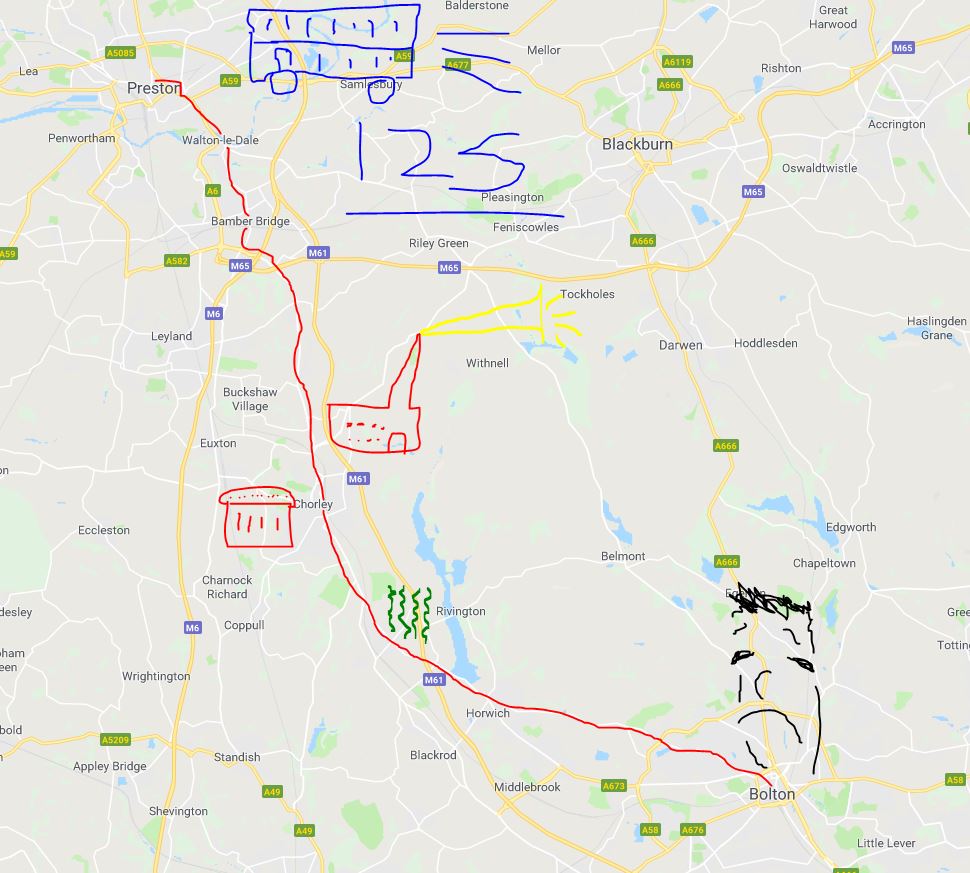
Route: 125, Bolton to Preston
Operator: Stagecoach
Timetable: Every 10 mins (Mon-Fri); every 12 mins (Sat); every 30 mins (Sun)
Time: ~1h 40m
Cost: £8.20 Lancashire DayRider
Date of Trip: 19/5/19
Preston to action: Ian & Eleanor
Bolton is a town which punches far above its weight when it comes to entertainers. From Maxine Peak to Peter Kay, Sara Cox to Hovis Presley, it knocks the socks off Peterborough, Poole, Portsmouth and other similarly sized towns and cities around the country. Even ones which don’t begin with a ‘P’. The weird thing is, though, for all of this performing arts panache, I’ve never seen anybody in Bolton smile. I must’ve been here at least a dozen times and have come across shoppers grumbling at the foot of the Fred Dibnah statue, a set-to outside Wilkos, and most chillingly of all, a pair of little girls skipping down the street with angry scowls on their faces.
This morning is no different. The Skylink footbridge which leads from the railway station to the new bus interchange has a stocky, shaven-headed guy on it, swaggering slowly in his prison-grey tracksuit bottoms, snarling at people heading in the opposite direction. He’s kept on a short leash – metaphorically, although physically mightn’t be a bad idea – by a short woman with spiky bleached hair, presumably his mum, who is the only relaxed person on the whole walkway as she drags to vapours out of an e-cig.
The town’s reputation takes a further battering once we reach our stand. A man who has had an eventful evening, judging by the small patch of dried blood spattered on his orange shirt, salutes a bus leaving a neighbouring bay before giving it the vees and a verbal volley, before promptly falling asleep in a metal chair. Thankfully, our bus pulls in with a few minutes to spare and we race to the front of the top deck to make sure that our new friend doesn’t wake from his temporary slumber.
The 125 isn’t any old bus. Oh no, this is a Stagecoach Gold service, meaning that we get a fleur-de-lis motif on the floor rather than the usual circular corporate logo. It eases our passage immeasurably, although I’m not so sure about the sweaty leather seats. Buses to Bury, Wigan and Leigh are filling up as we head on our way, with progress slowed by an F1-style pitlane, where an LCD screen admonishes drivers who push the boundaries of the 5mph speed limit.
We pick our way through the town centre, past the grand old Turkish Baths which are once again empty after a revival of sorts as offices, and Bamboogy, a nightclub with all the glitterballs and 2-4-1 offers you can shake your tail feather at. It’s also the place to go to celebrate Easter, as they had a ‘Maundy Thursday Crème Egg Giveaway!’ last month; I just hope that the DJ played ‘I Am The Resurreggtion’.
Our route continues up Chorley Old Road, breezing close to bay-fronted terraces and the Everlasting Hair & Beauty salon – a bold claim if there ever was one. It was somewhere around here that I once trained with the Bolton Robots of Doom baseball team, for the first episode of a radio feature called ‘I Always Thought I’d Be Quite Good At…’. The premise was that I’d throw myself in at the deep end with a pursuit, sporting or otherwise, which I mistaken believed I’d have some kind of aptitude for. I genuinely do enjoy baseball, as much for the statistics as the game itself, but soon realised how chronically unfit I was when a tankard of sweat made good its escape from my pores during the warm-up. Bravely fighting the urge to puke my guts up, I was shown how to throw the baseball, catch it with a mitt, and smack it against a fence with a big bat. In our final exercise before I faced my first real pitch, I launched the ball from first base to the home plate only to recoil in agony. I’d torn my bicep. My Moneyball dreams were in tatters and my arm still isn’t right eight years later.
‘The show never even got nominated for a Sony Award, you know.’ I mention, still partially in shock.
‘At least you’ll be able to tell people that you’re carrying an old baseball injury.’ Eleanor replies.
‘I do!’
‘There’s a shock.’
‘And I bruised my hand…’
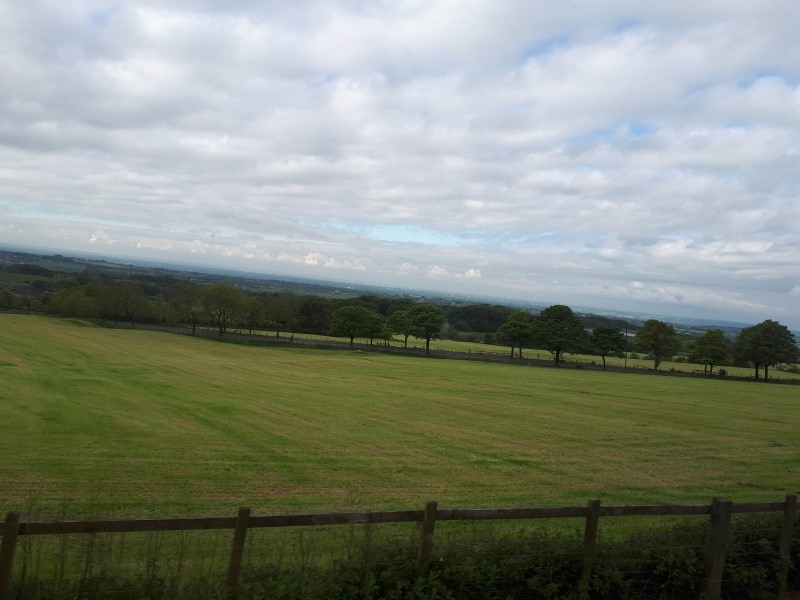
Our plush carriage moves on via the evocatively named Doffcocker and the Tempest Arms, where four-time Women’s World Champion darts player, Lisa Ashton, toes the oche. The area is beneath Winter Hill, where its eponymous transmitting station beams TV and radio signals out to seven million people throughout the North West and the edges of North Wales. This is something that my nana and grandad were eternally grateful for, as even though they didn’t watch Channel 4, they didn’t want to be lumbered with S4C at their caravan near Rhyl.
Hundreds of feet below us in the distance, Bolton Wanderers’ stadium catches a few tentative rays of sunlight which are poking through the cloud, while a gigantic topiary rabbit guards the driveway to a house in Bottom o’ th’ Moor.
‘This is loads prettier than I expected.’ Eleanor grins as we pass a picturesque trout fishing lake on the descent into Horwich. ‘Why didn’t I know about it? It’s lovely.’
On the face of it, Horwich is an old-fashioned town with pockets of intact Victorian street furniture, but it has started to attract a moneyed crowd of late. Sswish tea rooms, gastropubs and restaurants bangs out sophisticated local grub alongside greasy spoons and a shrinking complement of regular boozers. It also has Tom’s Affordable Cars, an assertion which is much easier to corroborate than back at Everlasting Hair & Beauty. We are right on the border with Lancashire here, with Rivington Pike and its accompanying series of reservoirs dominating the views with their deep multitude of greens and blues. The only problem with being thrown into the countryside like this is that you often encounter agricultural smells, and a farmer has clearly been putting a muck spreader through its paces before breakfast. It’s so overwhelming, so acrid, so dense that we can practically see a hazy miasma rising into our nostrils. Before we lose consciousness, it dawns on me that it’s someone’s feet. Specifically, the feet of the man who got on just as we were leaving Horwich.
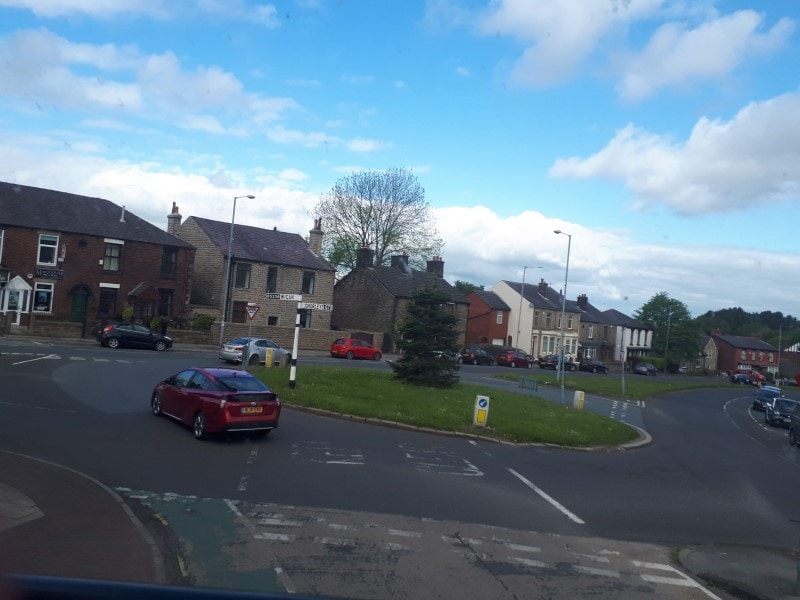
We regain our faculties just after he departs in Adlington, a mercifully short way up the road. It’s where we see two couples dressed in snazzy WWII garb, who are presumably on their way to the 1940s weekend over in Haworth. Either that, or we’re both hallucinating after five minutes of holding our breath. The gentlemen are very dapper with their finely twiddled moustaches, while the ladies are surely far more glamourous than is historically accurate. I should’ve checked to see if they had any gravy browning daubed onto the back of their legs.
The 125 reaches Chorley, where the roundabouts leading into centre are full of wicker characters performing various activities, such as gardening, sweeping, playing basketball and burning visitors. We’ve never been here before, but as the buses are so frequent, we make a quick detour to get a feel for it. Lined in bunting, Chapel Street is the traditional main shopping thoroughfare. Our first port of call is Malcolm’s Music Land, where we discover that Scouting For Girls don’t just have a Greatest Hits album, but they’ve also somehow got a Very Best Of with twenty tracks on it. Nineteen of them aren’t even ‘She’s So Lovely’.
Eleanor is itching to try Chorley’s culinary gift to the world: the butter pie. Greenhalgh’s are the bakery of choice, as anywhere which does a caulioccoli pie should be. A pigeon is eagerly pecking up any stray crumbs by the entrance, so it obviously gets the toes-up from the avian community, too. We find a bench and begin the feast.
‘Do you want some, Gingerface?’ she asks after her first mouthful has been ingested. ‘It’s nicer than those pasties in West Kirby.’
She’s right. Rather than just being a melted block of butter encased in pastry, it’s similar to a cheese and onion pie, albeit with the cheese being replaced by some mushed up spuds and a melted block of butter. Practically unknown outside their heartlands of Chorley and Preston, butter pies are surely due much wider recognition, no matter what the medical profession may have to say about it.
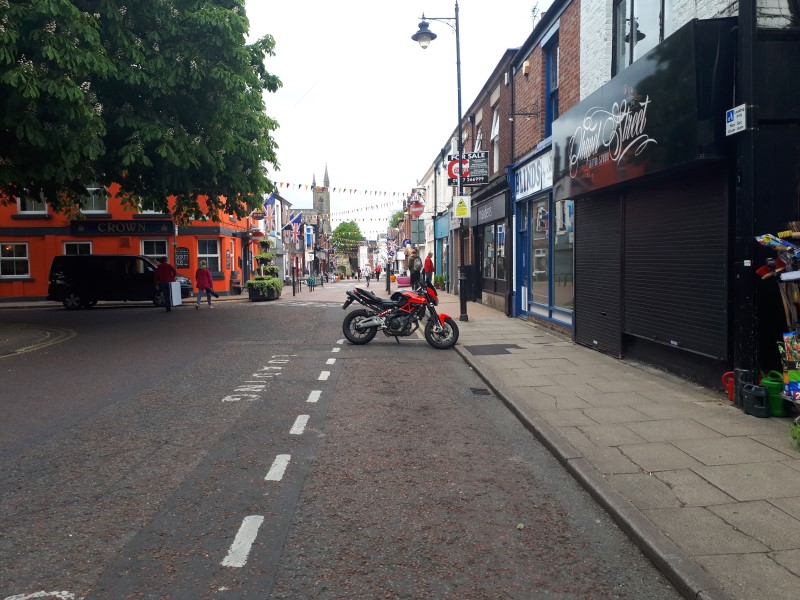
Back on the bus, another Central Lancashire quirk is that this is also a Mormon stronghold. The sect was here long before they ventured into the deserts of Utah, first putting down roots as long ago as 1837. Their oldest surviving building in the world is in Preston, while just outside Chorley is a chalk-coloured spire with a golden angel blowing a horn from the apex. This is the Preston England Temple, the geographically inaccurate name (Preston is still ten miles away) for one of their UK training bases, where missionaries are toughened up so that they can be ignored by hundreds of people per hour while holding leaflets up outside supermarkets, leisure centres and transport hubs. Perhaps they employ rejection therapy, a concept dreamt up by Jason Comely, a Canadian who thought it’d be a nifty way for people to gain strength by overcoming their fears of being told ‘no’.
It’s a striking building, mind you, even if we can only see the top half poking above the trees.The temple points the way into Whittle-le-Woods, where having at least two cars parked outside your home is a minimum requirement for residency. It also has a retro red phone box, which the villagers bought from BT for just £1 and converted into a diminutive book swap library. A little further down Preston Road in Clayton-le-Woods, another has been painted yellow and holds a prominently placed public defibrillator. They’re fantastic uses of iconic structures, which BT are more than happy to palm off onto whoever is willing to take on the cost of their upkeep. Others around the country have been turned into art galleries, coffee shops and even a shower.
We turn off the main road to take a quick tour of Clayton Brook, an estate with a typical array of grey rendered houses and red brick flats. There are chicanes to negotiate, designed to slow down any would-be Lewis Hamiltons, and Lancashire’s widest bulldog eagerly dragging its owner to the nearest field for a Saturday morning game of fetch. After darting over the M65 and M6 in quick succession, we reach Bamber Bridge. Its 25ft tall weathered steel welcome sign incorporates a cut out of a tree, in a nod to the town’s Old English toponym of Tree Trunk Bridge. It’s also where one of the UK’s most obscure bouts of racial violence occurred.
The Battle of Bamber Bridge happened in the summer of 1943, when a segregated American regiment of white officers and black troops, who were stationed in town, came to blows at Ye Old Hob Inn. It occurred later in the same week that 34 people had been killed in race riots in Detroit, and flared up when some soldiers tried to buy more beer after last orders. A couple of passing US military police (MP) officers were flagged down by two of the group’s officers, who aggressively confronted the men in the pub. One Private, Lynn Adams, was aggrieved enough to wield a bottle at the MPs, one of whom responded by drawing his gun. The situation was diffused, but the soldiers were intercepted on their way back to base, with another Private, Eugene Nunn, resisting arrest by thumping one of the MPs. A scrap broke out, with Adams taking a bullet to the neck and being refused hospital treatment, as were four other casualties injured in the skirmish. Word got out that the military police were actively looking to shoot black soldiers, and once an armoured vehicle with a machine gun strapped to it arrived on site, the troops tooled up in the camp’s gun room.
A four-hour exchange of fire progressed through the night, resulting in the death of Private William Crossland, with two more wounded on either side of the conflict. In the event’s immediate aftermath, commanders tried to impose racial segregation in Bamber Bridge itself. The locals agreed, with the town’s pubs all putting up signs insisting on ‘Black Troops Only’.
32 participants were found guilty of various offences at a court martial, but their sentences were reduced on appeal after the MPs and officers responsible were found to have goaded their countrymen with racial slurs, as well as having the majority of the blame placed firmly at their doors.
The bus saunters into Walton-le-Dale, where an ‘Amazing Female Vocalist’ is to be the star turn in the Sir Robert Peel pub tonight, although the flying commas they put around her description suggests that they are hedging their bets. It would’ve been worse if they’d have just put them around ‘Vocalist’, so small mercies and all that. It’s a short hop from here over the River Ribble and into Preston proper. A combination of the A6 and A59 threads us directly into the city centre, which has come off significantly worse for wear in a wrangle with the post-war town planners. Retail parks rub their boxy shoulders next to hastily cobbled together office blocks, while a busy dual carriageway keeps most residents at arm’s length. It’s bitty and disjointed but is also home to one of the UK’s most celebrated Brutalist structures.
Prior to its ongoing renovations, Preston bus station was a concrete slab par excellence. Even as a devout Brutalism naysayer, its uncompromising ugliness was something to behold. A standout design defaced by using the cheapest material this side of papier-mâché, its colossal tally of eighty stands have been halved over the past couple of years (only 74 services use the station), but they’re only still standing at all because of a campaign to save it. Earmarked for demolition by Council decree in 2012, The Twentieth Century Society petitioned to have it declared a Grade II listed building, a plea which was awarded the following year, saving its particularly crispy bacon. It celebrates its 50th birthday this year.
The 125 pulls into its stall, and although we are both parched after that butter pie, our next bus is already loading a couple of bays away. It’s the X2 to Liverpool. Boss!
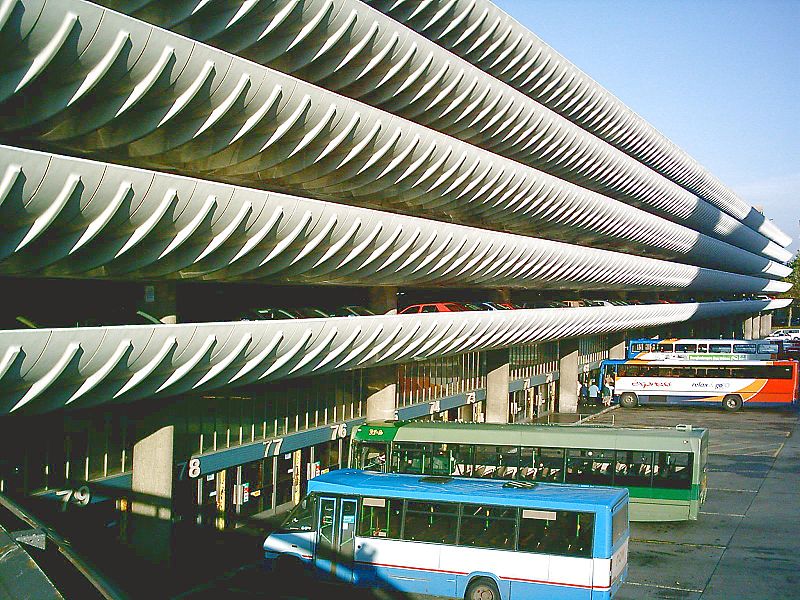
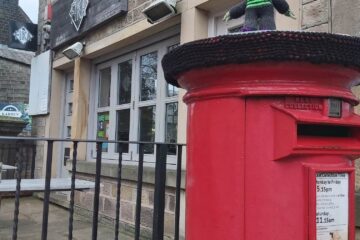
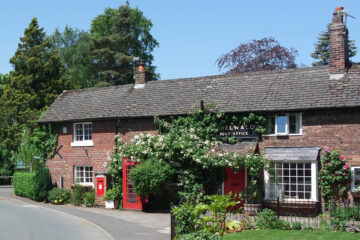
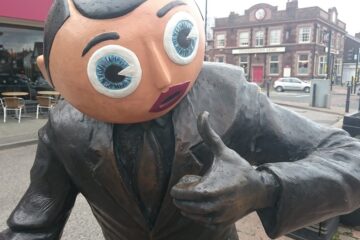
0 Comments